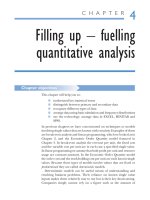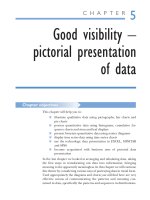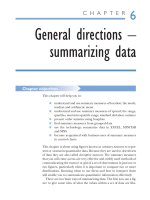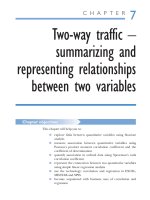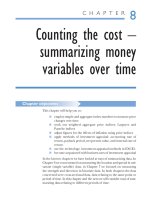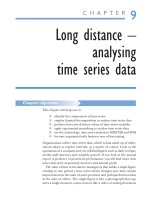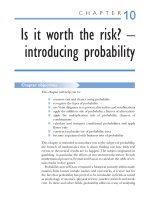Research methods for business 5th ch12
Bạn đang xem bản rút gọn của tài liệu. Xem và tải ngay bản đầy đủ của tài liệu tại đây (641.52 KB, 34 trang )
Slide 12.1
Chapter 12
Analysing quantitative data
Saunders, Lewis and Thornhill, Research Methods for Business Students, 5th Edition, © Mark Saunders, Philip Lewis and Adrian Thornhill 2009
Slide 12.2
Saunders, Lewis and Thornhill, Research Methods for Business Students, 5th Edition, © Mark Saunders, Philip Lewis and Adrian Thornhill 2009
Slide 12.3
Quantative data analysis (1)
Key points
• Data must be analysed to produce information
• Computer software analysis is normally used for
this process
• Data should be carefully prepared for analysis
• Researchers need to know how to select and use
different charting and statistical techniques
Saunders, Lewis and Thornhill, Research Methods for Business Students, 5th Edition, © Mark Saunders, Philip Lewis and Adrian Thornhill 2009
Slide 12.4
Quantative data analysis (2)
Main concerns
• Preparing, inputting and checking data
• Choosing the most appropriate statistics to
describe the data
• Choosing the most appropriate statistics to
examine data relationships and trends
Saunders, Lewis and Thornhill, Research Methods for Business Students, 5th Edition, © Mark Saunders, Philip Lewis and Adrian Thornhill 2009
Slide 12.5
Saunders, Lewis and Thornhill, Research Methods for Business Students, 5th Edition, © Mark Saunders, Philip Lewis and Adrian Thornhill 2009
Slide 12.6
Saunders, Lewis and Thornhill, Research Methods for Business Students, 5th Edition, © Mark Saunders, Philip Lewis and Adrian Thornhill 2009
Slide 12.7
Preparing, inputting and checking data
(1)
Main considerations
• Type of data (scale of measurement)
• Data format for input to analysis software
• Impact of data coding on subsequent analyses
• Case weighting
• Methods for error checking
Saunders, Lewis and Thornhill, Research Methods for Business Students, 5th Edition, © Mark Saunders, Philip Lewis and Adrian Thornhill 2009
Slide 12.8
Saunders, Lewis and Thornhill, Research Methods for Business Students, 5th Edition, © Mark Saunders, Philip Lewis and Adrian Thornhill 2009
Slide 12.9
Saunders, Lewis and Thornhill, Research Methods for Business Students, 5th Edition, © Mark Saunders, Philip Lewis and Adrian Thornhill 2009
Slide 12.10
Saunders, Lewis and Thornhill, Research Methods for Business Students, 5th Edition, © Mark Saunders, Philip Lewis and Adrian Thornhill 2009
Slide 12.11
Saunders, Lewis and Thornhill, Research Methods for Business Students, 5th Edition, © Mark Saunders, Philip Lewis and Adrian Thornhill 2009
Slide 12.12
Saunders, Lewis and Thornhill, Research Methods for Business Students, 5th Edition, © Mark Saunders, Philip Lewis and Adrian Thornhill 2009
Slide 12.13
Preparing, inputting and checking data
(2)
Defining the data type
Saunders et al. (2009)
Figure 12.1 Defining the data type
Saunders, Lewis and Thornhill, Research Methods for Business Students, 5th Edition, © Mark Saunders, Philip Lewis and Adrian Thornhill 2009
Slide 12.14
Preparing, inputting and checking data
(3)
Defining the data type
Saunders et al. (2009)
Figure 12.1 Defining the data type (Continued)
Saunders, Lewis and Thornhill, Research Methods for Business Students, 5th Edition, © Mark Saunders, Philip Lewis and Adrian Thornhill 2009
Slide 12.15
Saunders, Lewis and Thornhill, Research Methods for Business Students, 5th Edition, © Mark Saunders, Philip Lewis and Adrian Thornhill 2009
Slide 12.16
Preparing, inputting and checking data
(4)
A simple data matrix
Saunders et al. (2009)
Table 12.1 A simple data matrix
Saunders, Lewis and Thornhill, Research Methods for Business Students, 5th Edition, © Mark Saunders, Philip Lewis and Adrian Thornhill 2009
Slide 12.17
Saunders, Lewis and Thornhill, Research Methods for Business Students, 5th Edition, © Mark Saunders, Philip Lewis and Adrian Thornhill 2009
Slide 12.18
Saunders, Lewis and Thornhill, Research Methods for Business Students, 5th Edition, © Mark Saunders, Philip Lewis and Adrian Thornhill 2009
Slide 12.19
Preparing, inputting and checking data
(5)
Main data categories for coding
• Numerical data
• Categorical data
• Missing data
Saunders, Lewis and Thornhill, Research Methods for Business Students, 5th Edition, © Mark Saunders, Philip Lewis and Adrian Thornhill 2009
Slide 12.20
Preparing, inputting and checking data
(6)
Final stages of the process
• Entering data – rubbish in = rubbish out!
• Weighting cases
• Always take time to check for errors – including
illegitimate codes, illogical relationships and that
rules were followed in filter questions
Saunders, Lewis and Thornhill, Research Methods for Business Students, 5th Edition, © Mark Saunders, Philip Lewis and Adrian Thornhill 2009
Slide 12.21
Exploring and presenting data (1)
Exploratory analysis can include:
• Specific values
• Highest and lowest values
• Trends over time
• Proportions
• Distributions
Sparrow (1989)
Saunders, Lewis and Thornhill, Research Methods for Business Students, 5th Edition, © Mark Saunders, Philip Lewis and Adrian Thornhill 2009
Slide 12.22
Exploring and presenting data (2)
Checklist Box 12.8
Complete the Checklist in Box 12.8
to help you design diagrams and tables
Saunders et al. (2009)
Saunders, Lewis and Thornhill, Research Methods for Business Students, 5th Edition, © Mark Saunders, Philip Lewis and Adrian Thornhill 2009
Slide 12.23
Exploring and presenting data (3)
Showing aspects of individual variables
• Specific values
• Highest and lowest values
• Trends
• Proportions
• Distribution of values
Saunders, Lewis and Thornhill, Research Methods for Business Students, 5th Edition, © Mark Saunders, Philip Lewis and Adrian Thornhill 2009
Slide 12.24
Examples of diagrams (1)
Bar Chart
Source: adapted from Eurostat (2007) © European Communities, 2007
Reproduced with permission
Figure 12.2 Bar chart
Saunders, Lewis and Thornhill, Research Methods for Business Students, 5th Edition, © Mark Saunders, Philip Lewis and Adrian Thornhill 2009
Slide 12.25
Examples of diagrams (2)
Histogram
Saunders et al. (2009)
Figure 12.4 Histogram
Saunders, Lewis and Thornhill, Research Methods for Business Students, 5th Edition, © Mark Saunders, Philip Lewis and Adrian Thornhill 2009



